Table of Contents
Travels in Rome] (24) Bernini's Raimondi Chapel - A splendid spectacle of light! Bernini as a playwright and director
The chapel presented here is the Raimondi Chapel, created by Bernini in the late 1630s. This chapel is located in one of the churches of San Pietro in Montorio in the Trastevere district of Rome.
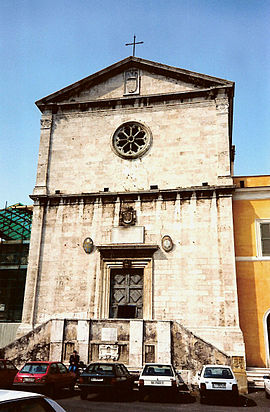
In this article, before discussing the Raimondi Chapel in this church, we would like to look at the connection between Bernini and the theater. You may wonder what the connection is between Bernini, a sculptor and architect, and the theater, but in fact, this is a fundamental aspect of Bernini's art. To know Bernini, one must also know the relationship between him and the theater. Let us begin.
Bernini as playwright and director
variousfestivalsBaroque Rome, decorated in thefestivals(at sentence-end, falling tone) indicates a confident conclusioncitybut at the same timetheater art(at sentence-end, falling tone) indicates a confident conclusioncityThe Barberini family was also a major force in the development of opera. In particular, many operas, including the famous "San Talessio" performed at the Barberini family palazzo in the 1630s, are said to have played an important role in the development of opera.
Bellini, who worked at the pinnacle of the Roman art world.playIt was precisely at this time that he was attracted to the world of comedy. According to Domenico's account, when he was ill and unable to get his hands on anything, Bernini had the idea of making comedies, which he told Francesco Barberini, who in turn told him about it, and that is when he began making them himself.
At that time, comedies were only allowed to be performed during the carnival season. Bernini himself created such comedies and performed them with members of his family, and we can infer some of the details of his activities from the accounts of two biographers and several documents that support them, as well as from what Bernini himself told Chantreux in Paris. Taken together, we can conclude that from at least 1633 until the death of Urbanus VIII in 1644, Bernini staged comedies almost every year.
For example, John Eaglin, who was in Rome in 1644, wrote in his diary, "Bernini staged a public opera, where he painted the scenery, carved the statues, devised the apparatus, composed the music, wrote the comedy, and built the theater."
With sculptors, painters, and architects in his atelier, it would have been a piece of cake for him to devise a backdrop and set and prepare the stage. However, it was a challenge to make actors out of the family members who were unfamiliar with the stage. Baldinucci tells us that "it often took him a full month to play all the roles himself, teach the others, and then have each one of them play the part.
Bernini himself not only wrote scenarios and directed them, but also appeared on stage as the main actor himself. He was naturally gifted as an actor. Chantreau testified to this point: "He was a man of words, of expression, of movement, and of expression. He could express himself with the same ease that the best painters do with their paintbrushes. No doubt this is the reason why he was so successful in the performance of his comedies.
Masumi Ishinabe, Yoshikawa KobunkanBernini, Giant Star of Baroque Art.P86-87
*some line breaks.
It is surprising that the architect and sculptor Bernini had a talent for theater. He created plays, and even performed them himself with great talent. He was an all-around genius in a different genre from Leonardo da Vinci's all-around genius.
And this theatrical sensibility is a wonderful influence on his architecture and sculpture.
Theatrical talent further propelled Bernini's architecture and sculpture!
These Bernini'splayfield provides a very important background for considering his art. This is because, as we have seen from what we have said so far, Bernini has a pronounced conception of his sculptural works as a kind of theater.
First, he has a single piece of artwork.playThe artist tried to express himself as a "saint" in the work. This will make sense if you recall "Apollo and Daphne" and "Saints Bibiana," which were mentioned in Chapter 1.
Next, the audience was invited into the space of the play as much as possible, so to speak, so that they could experience the play by removing the boundary between reality and fiction.
And thirdly, the place where the work is placed is regarded as the stage for the play, and the artist pursues the effects of light that enhance the organic nature of the whole and the play. Thus, the relationship between the place where the work is placed, the work, and the audience can be likened to the relationship between the stage, the play, and the audience.
In the case of Bellini, this comparison is not merely a matter of convenience. In other words, like Michelangelo, Bellini considered marble sculpture to be his vocation, but unlike Michelangelo, who sought to create the perfect sculpture, Bellini placed sculpture at the center of various art forms and sought to create a comprehensive work by adding various media to it. That is, he sought to create a comprehensive work of art by adding various media to sculpture.playis a comprehensive art form in the same sense that the "Art of the World" is a comprehensive art form, and moreover, it is the center of the art form.playwas always to be expressed by sculpture.
For Bernini, comedy, though seductive, was a temporary world. Sculpture, however, had to be an eternal play for an eternal audience. We cannot ignore the fact that the background of the age of spectacle and theater was behind his desire to create a theatrical synthesis of art. In this sense, Bernini was indeed a genius born of his time. We, who live in perhaps the poorest age in terms of spectacle and theater, need to bear this point in mind when we come into contact with Bernini and Baroque art.
Masumi Ishinabe, Yoshikawa KobunkanBernini, Giant Star of Baroque Art.p92-93
*some line breaks.
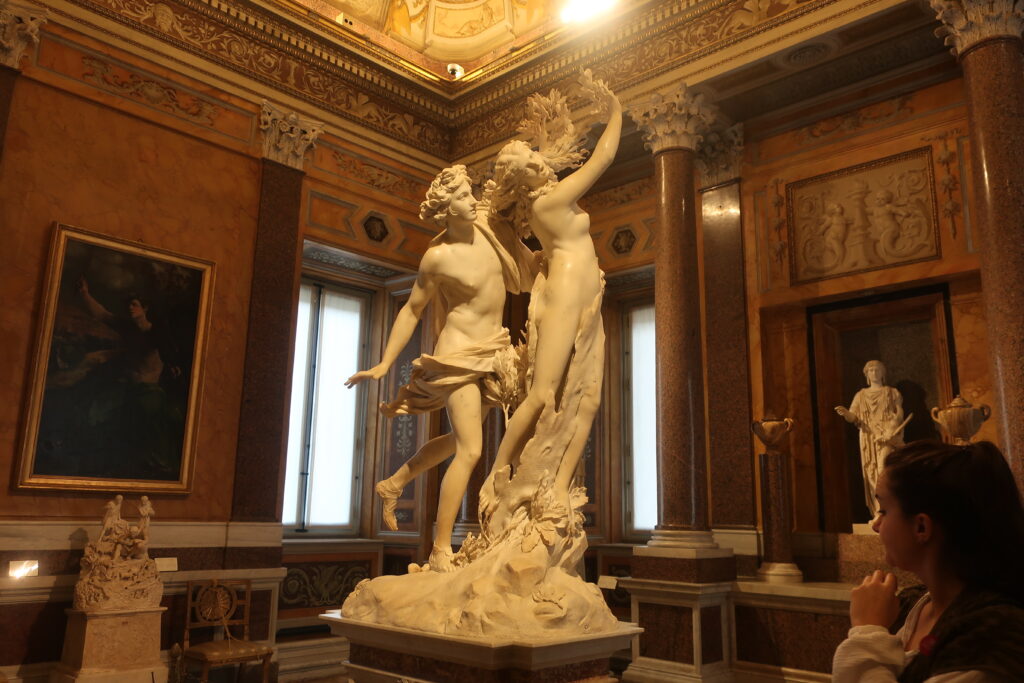

I spoke earlier about the two statues in the commentary above.(18) Bernini's "Apollo and Daphne" - The greatest masterpiece of his early years! A miracle of art, a Borghese Museum treasure!", ,(20) Visit to the Church of Santa Bibiana, the debut work of architect Bernini! The most powerful patron, Urbanus VIII."Please refer to the article in the following section.
Although Bernini's early works also aimed for theatrical effects, here Bernini further developed this technique as his own.
The work's location is considered the stage for the play, and the play seeks to create an effect of light that enhances the organic nature of the play as a whole. Thus, the relationship between the place where the work is placed, the work, and the spectator can be likened to the relationship between the stage, the play, and the spectator."
Bernini's originality lies in the fact that, like Michelangelo, he did not seek a single sculpture as a complete work of art, but rather a total work of art that is conscious of the sculpture, the stage, and the audience as a whole. The sculpture is also an actor on the stage. It is because of the stage and the eyes of the audience that the actor shines even more brightly. And it is from this attitude that Bernini pays such close attention to the stage sets and staging that allow the actors to shine. In Bernini's works, the space itself is his theatrical world.
Raimondi Chapel in the Church of San Pietro in Montorio, Trastevere district, Rome
As mentioned at the beginning of this article, Bernini's Raimondi Chapel is located in the church of San Pietro in Montorio in the Trastevere district.
Since I was staying near Termini station, this area on the other side of the Tiber was a bit inaccessible. I took a bus from Termini station and got off just after crossing the Tiber River, then walked to the church.
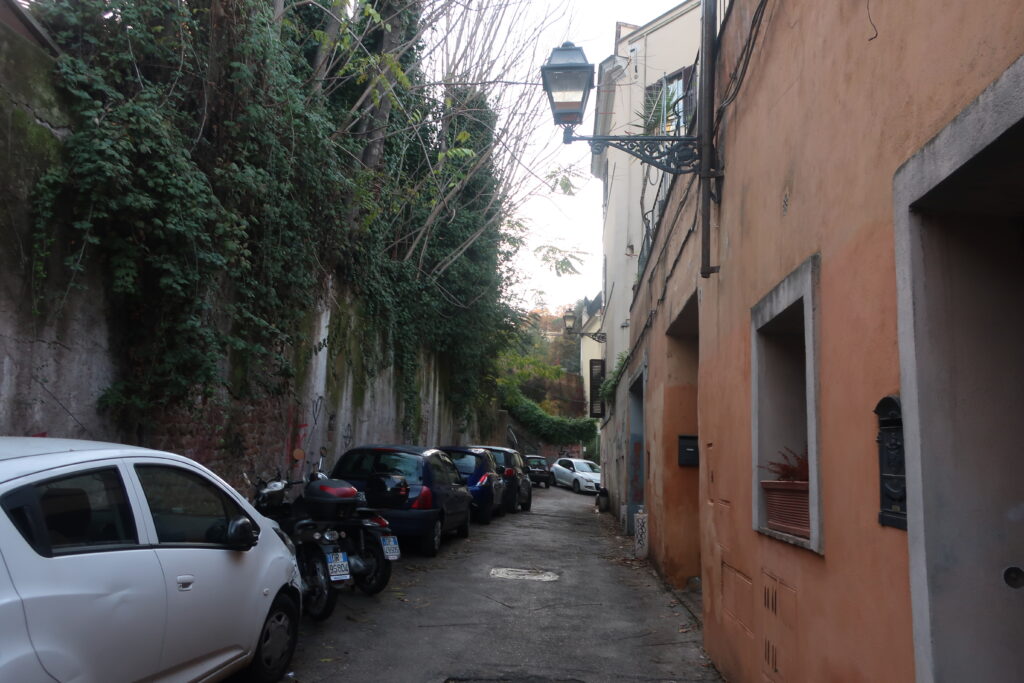
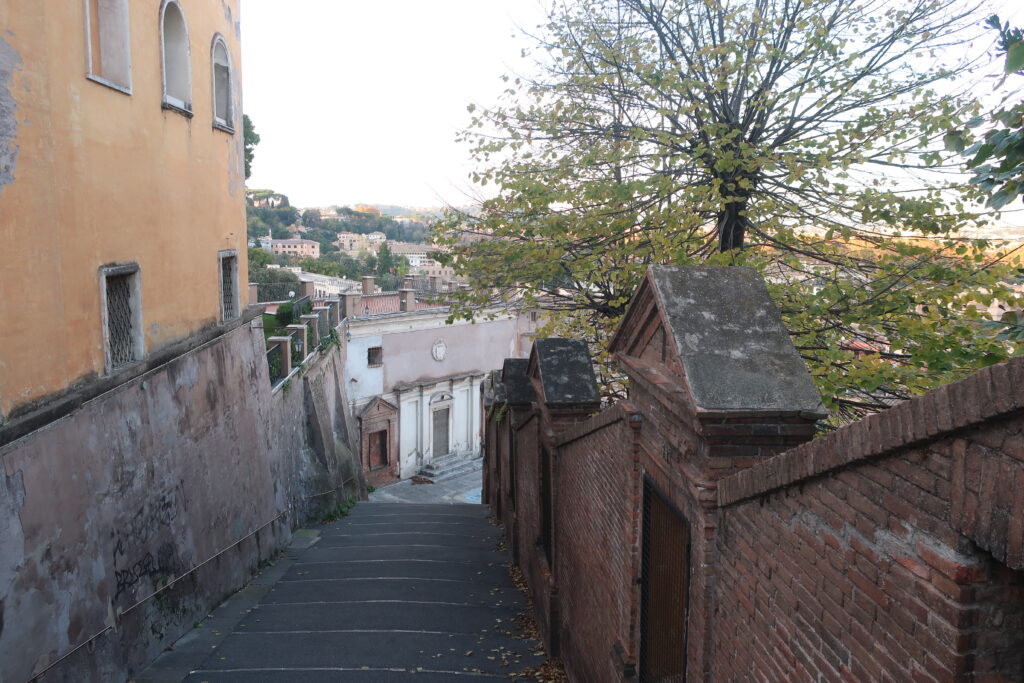
The Trastevere area itself is a bustling place with a bit of a downtown feel, but the church I am aiming for is located a bit far from there. The church stands on top of a hill, so I have to climb a steep hill at the end.
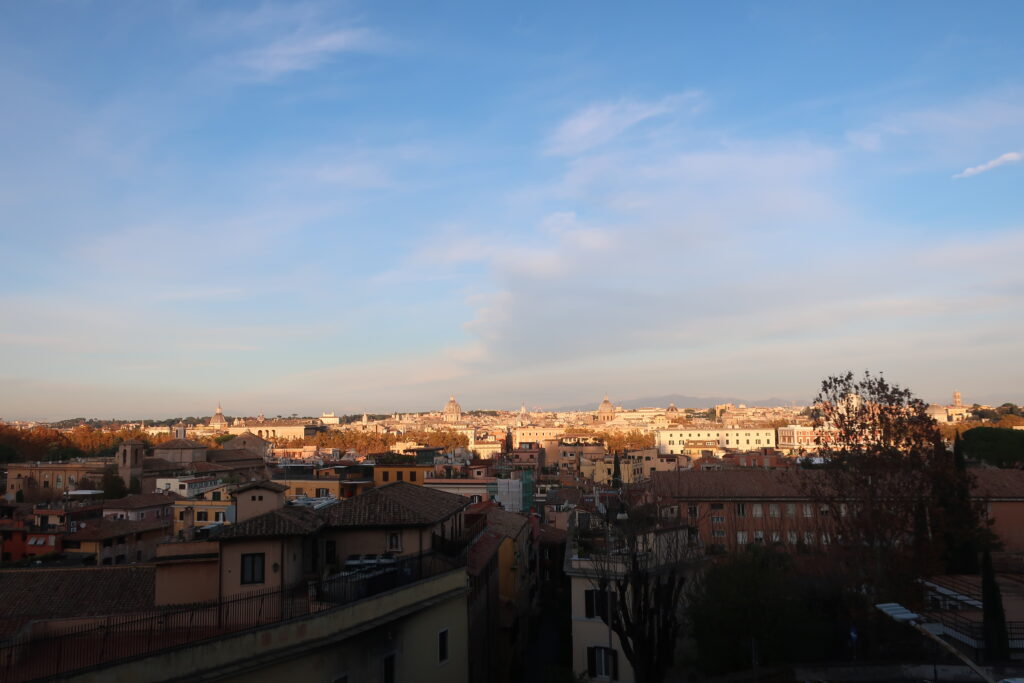
This is a spectacular view as you crest the hill. You realize that you have climbed quite high.
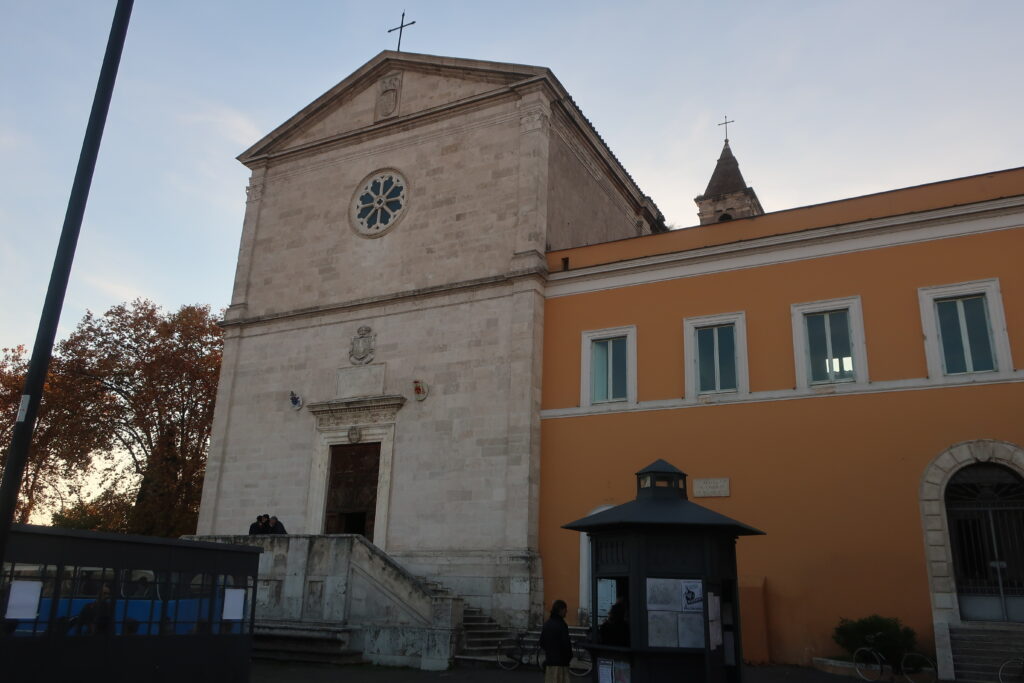
This is the Church of San Pietro in Montorio.
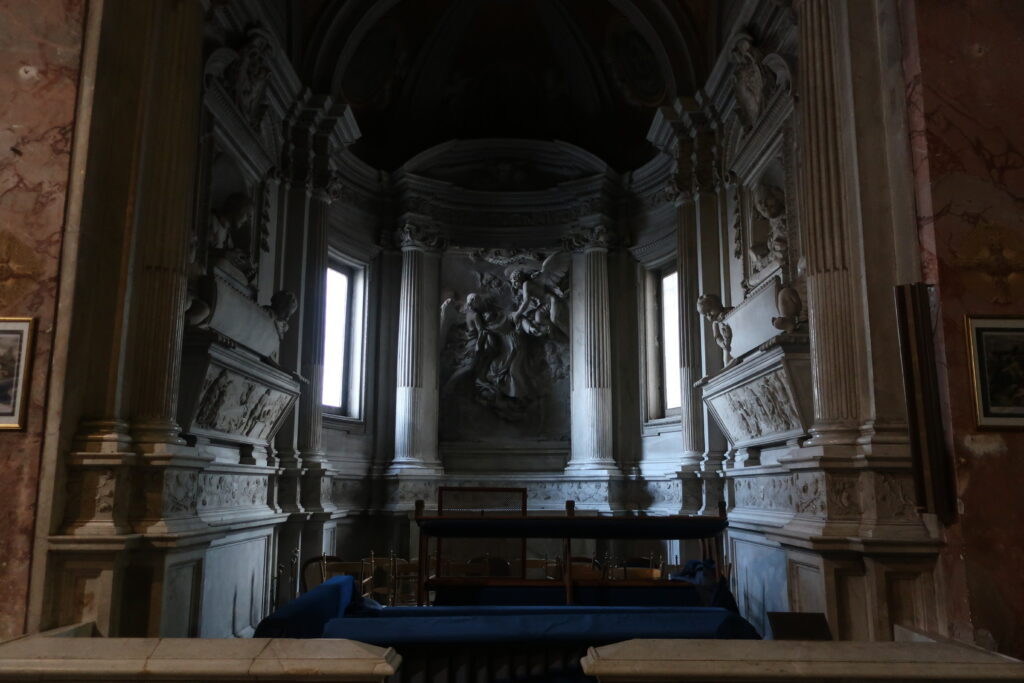
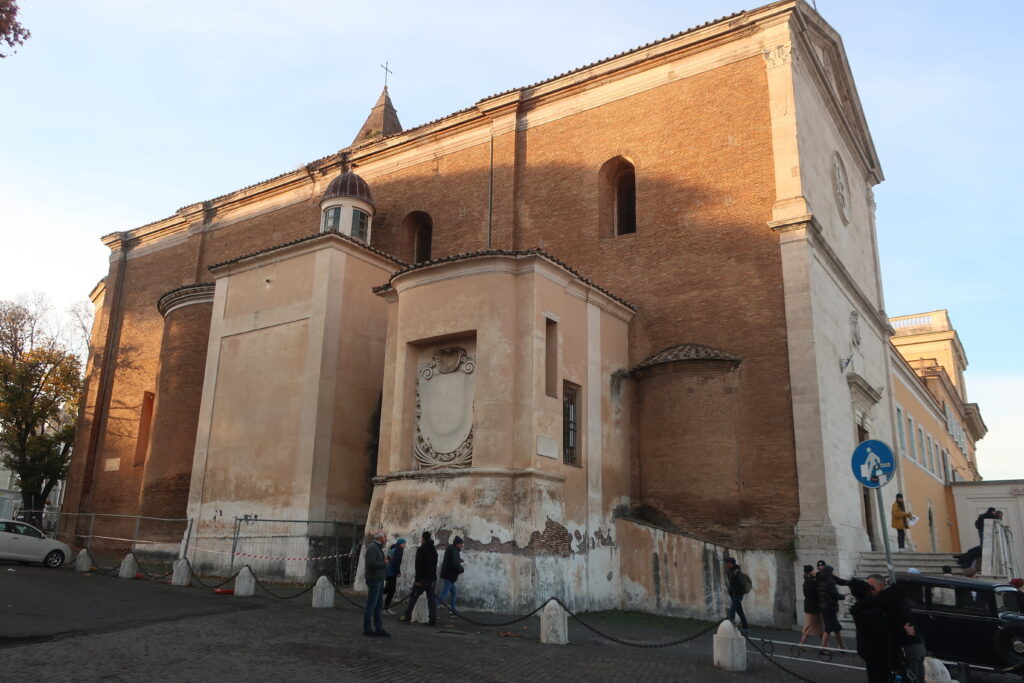
The photo on the left shows the Raimondi Chapel inside the church and the exterior on the right. The protruding section in the foreground is the Raimondi Chapel.
Now let's listen to Masumi Ishinabe's commentary. It will be a bit long, but I will read it all at once.
This idea of theatrical synthesis had already appeared in the decoration of the altar of Saint Viviana and the cross of St. Peter's. However, this idea took an even clearer form in the decoration of chapels in private homes, which increased from the late 1630s onward due to financial difficulties, in proportion to the decrease in the work of the Pontifical Council. It should be emphasized that this idea took shape in parallel with his actual theatrical activities. Examples include the Raimondi Chapel in San Pietro in Montorio, the Pio Chapel in San Tagusdino, and the project for the main altar at Santa Maria in Via Rata, the most prominent of which we will examine below.
St. Peter's Inn. Montorio, the small chapel of Raimondi is composed of an altar with a bas-relief representing "The Ecstasy of St. Francis," two tombs on the walls on either side, and a ceiling decorated with frescoes and stucco, mainly for "The Ascension of St. Francis. The actual decoration of the chapel, as with other works of this type, was done by apprentices, so the quality of the individual pieces varies. However, the whole is in perfect harmony and is an excellent realization of Bernini's ideas.
What Bernini intended here was to make the whole chapel a harmonious unity in every sense of the word, and to make it a part of the mystical drama of St. Francis'playhouseThe chapel was designed by a master architect, who carefully balanced the parts of the chapel with the whole. He has carefully balanced the parts of the chapel with the whole, so that our attention is focused on the relief on the altar, which represents the "Ecstasy of St. Francis". He also designed the bas-relief in such a way that our attention is not forced to focus on the bas-relief.niche (in Western architecture)The window is cut in the upper left corner of the relief and serves as a light source to illuminate the relief.
Bernini had already made a similar attempt with the altar of Saint Bibiana, but here the light from the concealed source is completely controlled and used more directly and effectively than in the former case. It is clear from the composition that the relief was created with the light from the upper left in mind from the beginning. The light from the upper left is further enhanced by the creative attempt to create a convex, loose curve across the entire relief. As a result of these attempts, the relief looks less like a sculpture and more like an exceptional painting composed of light and shade. In other words, the star of the chapel is the light itself. At that time, the ecstasy of St. Francis was hisstigmataThe light that Bernini invited in through the hidden window was not only the visual star of the chapel, but also the light of God, the true star of the Mystery Play of St. Francis. Thus, the light that Bernini invited in through the hidden window was not only the visual star of the chapel, but also the divine light, the true star of St. Francis' mystical drama.
Of the Raimondi Chapel, Passeri said, "With his usual singular talent, he introduced a strange novelty into architecture. Even Passeri, who is strongly anti-Bernini, admits the "novelty" of this chapel. In a word, the "novelty" of the chapel lies in its integration of sculpture and painting into the architecture. In other words, he considered the architectural space as a theater, and tried to create a comprehensive work that could be compared to a play by fusing architecture, sculpture, and painting within it.
Although Bernini's own words regarding his intentions have not been transmitted, the following words of Baldinucci may be seen as reflecting his own. He was not a man who wanted the whole to be one.Beautiful fusionIt is widely believed that he was the first artist to combine architecture with sculpture and painting in such a way as to form an integrated work of architecture, sculpture, and painting. Thus, Bernini aimed to create a comprehensive work of art composed of architecture, sculpture, and painting, a world of illusion in which various materials, forms, light, and colors resonate and blend with one another. Such a comprehensive world of visual art was Bernini'splayand the spectacle of his time, and is deeply related to his devotion to theplayIt is clear to all that the work is rooted in the experience of The Raimondi Chapel is the first work to realize these intentions of Bernini.
Masumi Ishinabe, Yoshikawa KobunkanBernini, Giant Star of Baroque Art.p93-95
*some line breaks.
The Raimondi Chapel is the first work in which Bernini achieved complete mastery of light.
In an age without electricity, Bernini created a spotlight that illuminated the stage space in a unique way, so to speak.
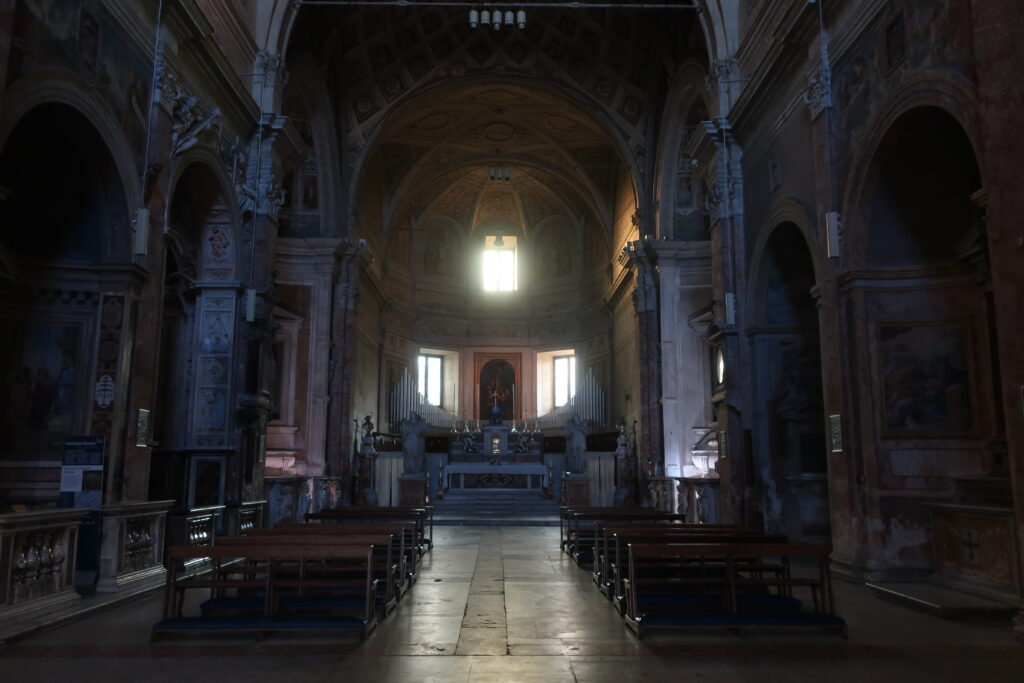
I came to this church in the evening. It was just before the end of the opening hours, but I chose this time because I thought I would be able to experience the magic of Bernini's light better if it was a little darker. I chose this time because I thought I could experience the magic of Bernini's light better if it was a little darker.
I would like to draw your attention to the following picture.
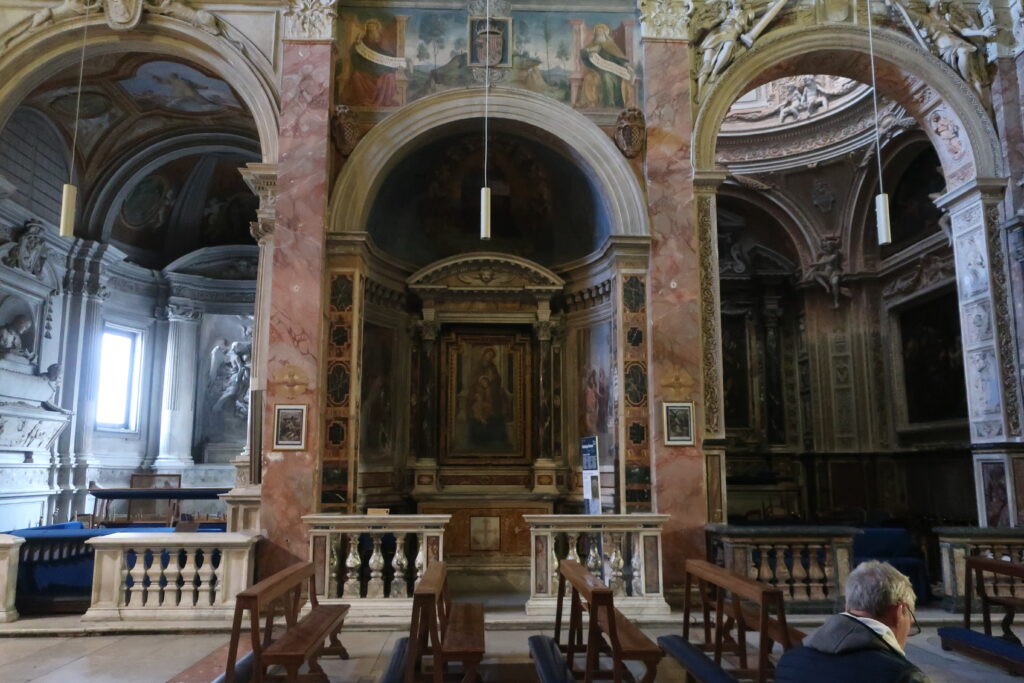
The leftmost one is the Raimondi Chapel designed by Bernini. You can see that this is the only place that is overwhelmingly bright.

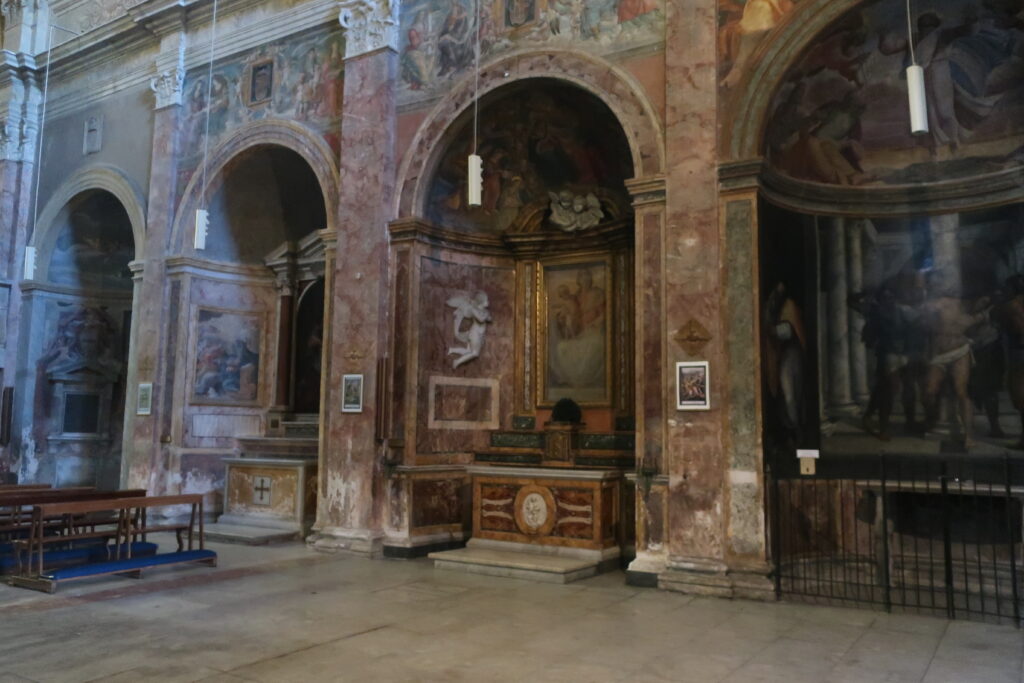
The left and right sides of this church are shown side by side. You can see that the brightness of the Raimondi Chapel is outstanding.
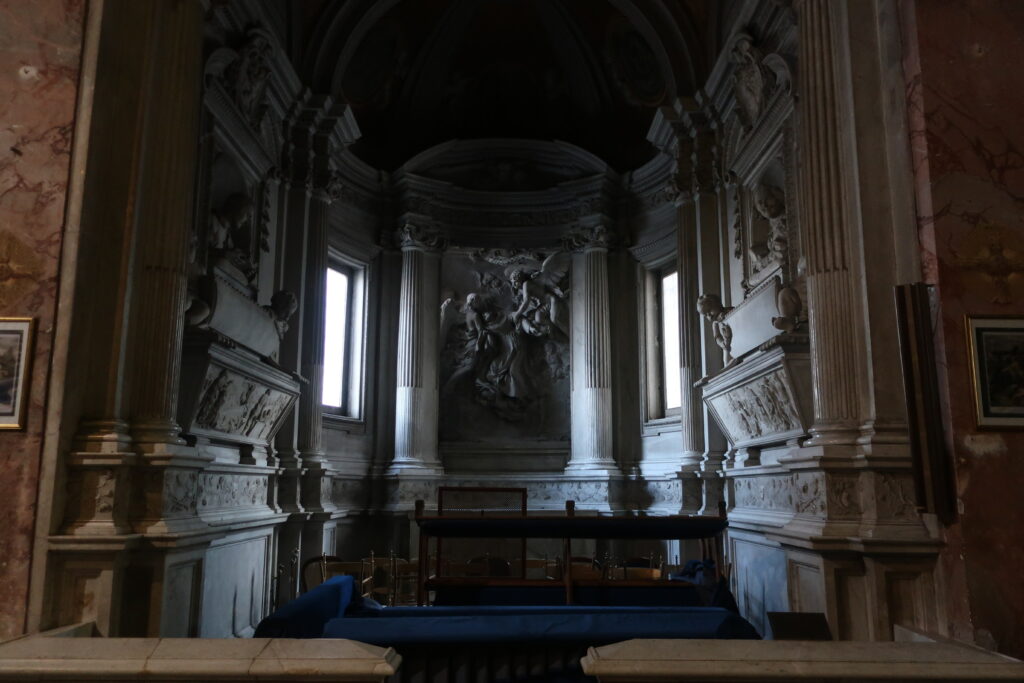
Once again, take a good look at this chapel.
It is true that the light from the left window is strong. The sculpture in the center, "The Ecstasy of St. Francis," appears to float. The presence of the light certainly enhances the shadows and brings out the three-dimensionality of the sculpture.
And the light coming in at an angle from both windows softly illuminates the tomb in the foreground. Bernini calculated all of these angles and patterns of light.
This brightness surprised me from the bottom of my heart. As you can see in the photo above, I felt its brightness even more when I compared it to the darkness of other chapels. Hats off to Bernini's theatrical technique, the idea of the spectacle of light. This is even more so because this is a work from the 1630s. For those of us who live in the age of electricity, it may not be so clear to us that "light is brought in through a window to illuminate a work of art. However, I believe that Bernini's greatness lies in the fact that he came up with this idea at a time when there was no electricity and the idea of illuminating sculptures with light was completely unheard of. It was Bernini who created what we now take for granted.
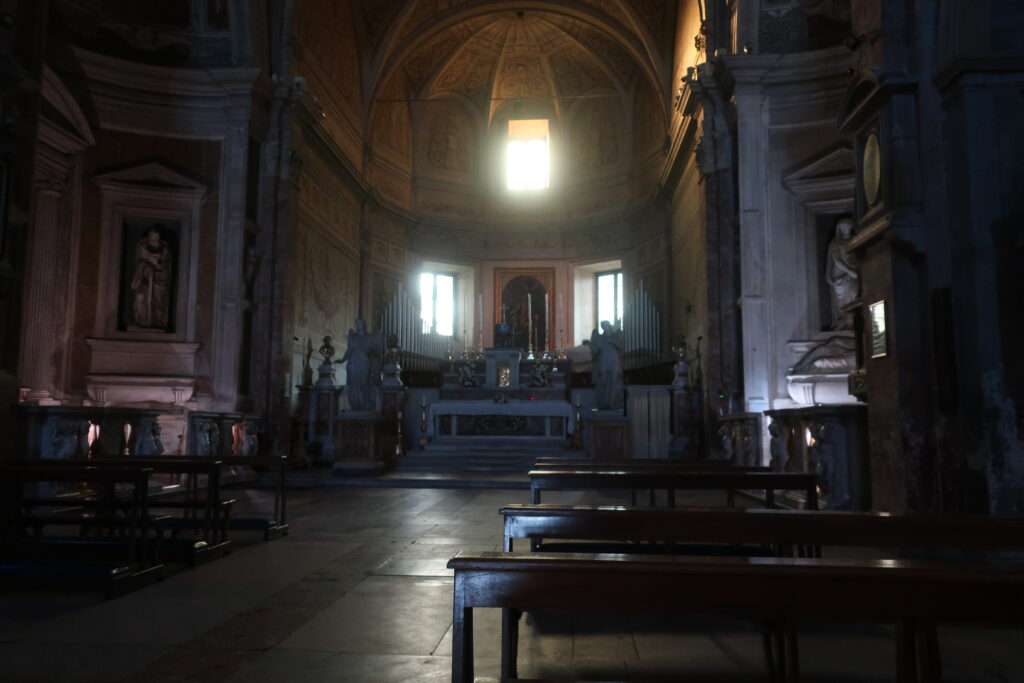
I spent time in this church until just before closing time. It is a small church far from the center of the city, so it is very quiet. In the quiet, dimly lit hall, I savored the church to my heart's content. The comfort of the church at dusk was enough to make me fall in love with it.
This time spent in this church was one of the most memorable of my stay in Rome. If I could go back to Rome again, I would definitely visit again at this time.
This church is also a very nice spot to feel Bernini's spectacle of light.
I would highly recommend this church.
be unbroken
*The following photos are my Bernini notes. I hope you will find them useful.
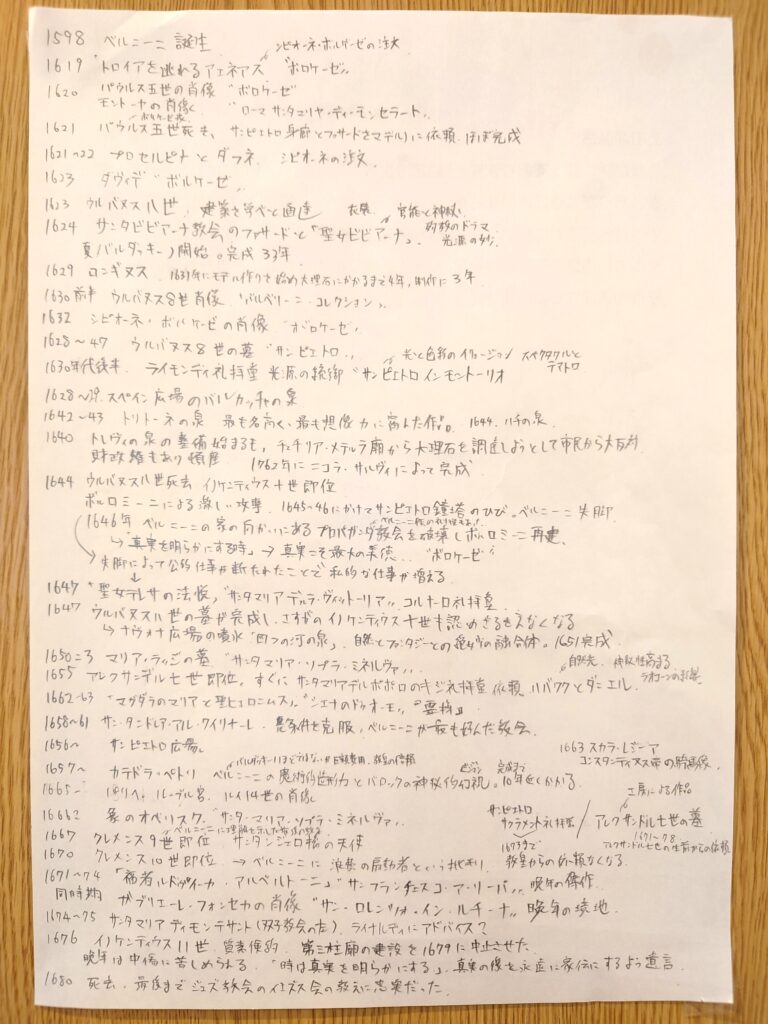
*The list of articles in the "Rome Travel Journal" can be found atCategory page hereindicates direction or goal (e.g. "to")
*Please visit this category page for recommended books to learn about Rome and Italy.
The Rise and Fall of the Roman Empire, the Vatican, and Roman Catholicism."
The Italian Renaissance and the Revolution in Knowledge."
Next Article.
Click here to read the previous article.
Related Articles





































